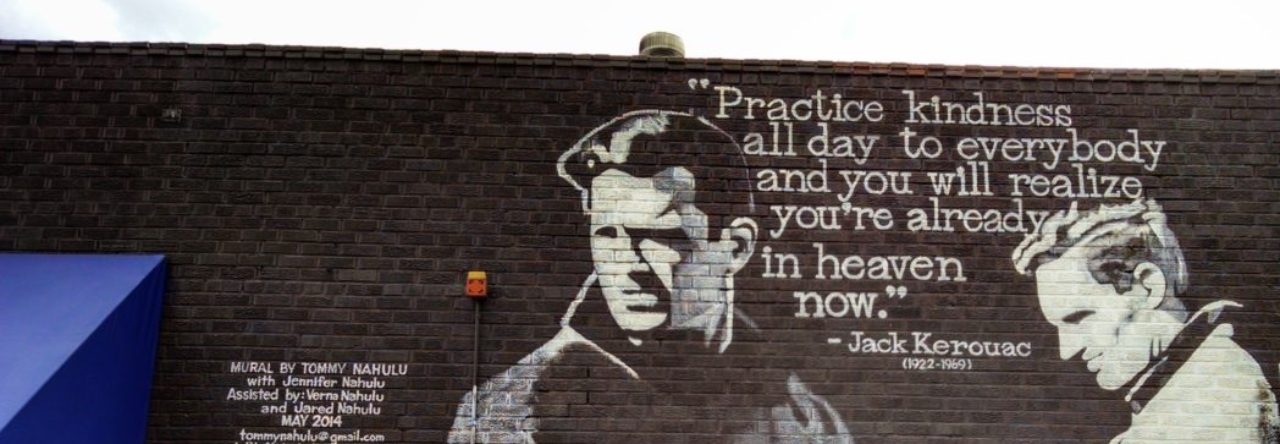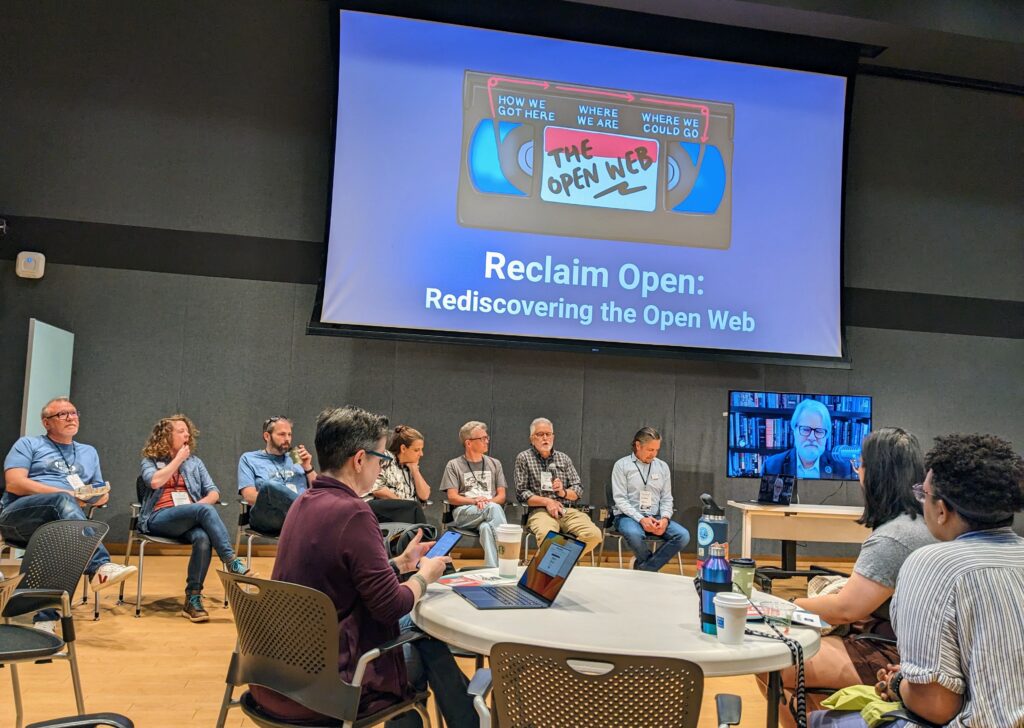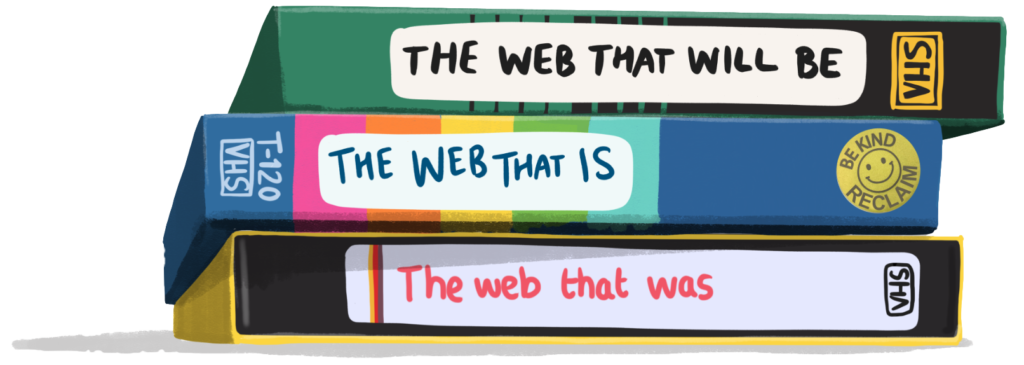Last week I attended Reclaim Open, a gathering of folks to reconnect and rethink the World Wide Web at age thirty. Where have we come from, where are we, where are we going? And I think the emphasis is on the “we” of the “web” … the people who connect and share and learn across an infrastructure that is at once material, technological, conceptual, and social. We reminisced about our earliest forays into the open spaces of the Web, thought about the winding pathways that we have wandered down, and pondered the Web of the future. As you might imagine at a Reclaim gathering, there was a distinct theme of recovering and re-presenting, or making present again, the best of the Web … the sense of experimentation, possibility, openness, and pro-social connection. In the face of the corporatization of the Web, of surveillance, trolling, paywalling, gatekeeping, performativity, etc., etc. … could we recover and reclaim this space as a place where genuine and authentic and human interaction can flourish?
The conference prompted me to retrace my pathway through almost thirty years of life on the Web, and I’ll recall some of those highlights soon enough, but first … the event itself was first and foremost about connecting and reconnecting with the stalwart band of folks who make up the Reclaim ed-tech community. To once again greet old friends and to meet new friends was to reclaim a form of presence that, for all its wonders, even the open Web itself cannot replicate. At the risk of leaving out by name many wonderful people, I’ll just mention a couple of those reconnections. Bryan Alexander was there to give the final keynote of the conference, and it happened that he and I twice together walked the thirty minutes or so from our hotel to the conference site at the UMW campus. Far from being incidental and interstitial times, these walks were delightful opportunities to chat with one of the most generous, kind, and productive persons in our field. And speaking of delightful … how good it was to see Laura Gibbs once again and to share tacos and ice cream on our last night in Fredericksburg. I could go on to give other highlights, but really, just go and watch for yourself the keynotes from Kathleen Fitzpatrick, Rajiv Jhangiani, and Bryan, as well as many of the outstanding breakout sessions.
The Web is old enough now to have layers of tradition, of practices and experiences that can be handed on, shared, built upon, but that can also become distorted and corrupted. And I recalled at one point the salience of some terms from my own background as a former full-time professor of theology, notably, the idea of anamnesis, which derives originally from a liturgical context and refers to “making present again,” or experiencing the meaning of past events as being fully present. Literally, it means” to not have amnesia,” and I think that’s one thing we were trying to do at Reclaim Open … to not have amnesia about the most formative and important elements of the Web. Mind you, this is not the same as “nostalgia,” although there were perhaps moments of that as well at our gathering. I think you can have both, in a way … you can look back wistfully at what was, while at the same time recommitting to making the best of the past present again.
When the Web emerged on the scene in the early to mid 1990s, I was teaching at a small seminary in southern Indiana, having lived in Washington DC the previous several years doing my graduate work in theology. So I had a life—even an adult life—before ever hearing of or experiencing the Web. And perhaps that’s not irrelevant when it comes to appreciating the sheer magic of the hyperlink. To this day I have not lost the sense of wonder about this marvelous invention. My first transport was that, though I had relocated to the rural midwest from DC, I could continue to read the Washington Post, which I had come to enjoy during my years in DC. It may not sound like a big deal today, but in 1995 I was thrilled that I could read the Post just as easily, and really, even more so, than I had before.
The platform of this magic carpet ride was Netscape Navigator. A browser, though I now wonder: how did the term “browser” come to designate that application through which we explore the Web? I mean, to “browse” means to look over casually or to skim … and (I didn’t know this), that’s actually a secondary sense of the term. To be sure, there was and is a fair amount of “casual skimming,” but the term may have some resonances that are less than fortunate … implying a lack of serious engagement, a skittering along the surface, an impermanence and ephemerality of contact and content. For me though, I thought of the web more as a great library that I could spend time in with deeper and longer forms of reading.
Soon enough, as we moved into the late ‘90s and early 2000s, the landscape (or netscape, of course) continued to evolve, and I began to curate a small collection of websites to visit and to draw on for both personal and professional purposes. This was clearly the era of Web 1.0, the read-only Web, and at that point I did not really have a strong impetus to create my own sites. I was beginning to learn basic HTML and became familiar with tilde spaces, but, for various reasons, I did not yet aspire to make my own venture into digital self-publishing. The first round of the browser wars was heating up, and I watched with dismay as Navigator was eclipsed by Microsoft Explorer. I felt that the “right” browser, the more aesthetically elegant browser, the browser that represented the plucky inventiveness of higher ed, had lost out to the corporate behemoth that was already using its near-monopoly power to control the desktop. But as we would later realize, what goes around comes around … and around and around again.
By the early 2000s we were offering the first online courses at my school. At the time it felt daring and innovative. It happened that on several occasions, I offered the same course at the same time to two different sets of students, an in-the-classroom group of (mostly) seminarians, and an online group of lay degree students. My bright idea was to record my in-classroom lectures (yes, they were mostly lectures … I didn’t know any better at the time) and to post them on whatever learning management system we were using—goodness, I don’t even remember what it was. Then I created forums where students from both groups would discuss readings, topics, ideas, etc. It doesn’t sound revolutionary today, I know, but at the time it really was, because at our school there weren’t so many opportunities for seminarians and lay degree students to interact on a serious theological level. There were revelatory moments as I discovered, for example, just how clerical some of the priests-to-be already were in their thinking. That’s a topic for another day. In any event, even though this technically was not taking place on the fully “open Web,” it gave me a sense of what could be in that space.
We were moving into Web 2.0, the “read-write” Web, though I was somewhat slow to embrace the “write” and “create” possibilities that new platforms and tools represented. All the same, my interest in academic technology continued to grow, and by the late oughts, I found myself beginning a transition toward a full-time career in ed-tech. I continued teaching theology part-time and picked up a master’s degree in Instructional Systems Technology (fully online) from Indiana University. I landed a gig as a “Digital Pedagogy Designer” at Austin College, a small liberal arts college not in Austin but in Sherman, TX, about an hour north of Dallas. I came as part of a Mellon-funded program, “Collaborative Pedagogies for a Digital Age,” and for three years got to do all the fun stuff … starting a blog, Digital Pedagogy @ Austin College, getting into the twittersphere, and supporting a bunch of cool faculty and student projects.
This was a time, in the early to mid 2010s, that I started to develop a more robust conceptual framework for what was happening online and on the Web. I had, for example, learned about the notion of the “personal cyberinfrastructure” from Gardner Campbell and the idea of “thinking like the web” from Jon Udell. It all made so much sense. I remember as I started my position at AC I came across an article in EDUCAUSE Review from 2014, “Reclaiming Innovation,” by Jim Groom and Brian Lamb … I know I read that piece several times as I felt myself trying to catch up and figure out the fuller scope of where we had come with the web and where we were going.
That article from almost ten years ago sounded so many of the same themes that we talked about at Reclaim Open last week. In 2014 we were in the early wake of the post-MOOC era, and even then, the cry was, “What happened to the open web?” “What happened to the energy and promise that animated the early web, when colleges and university campuses were the epicenter of web culture, having designed and built the entire internet infrastructure from which the web emerged?” “Where are we, two decades later?” And now it’s three decades later, and the questions still press on us … “Where are we?” I could go on, but really, go back and read that piece from Jim and Brian (though unfortunately, the videos from the original piece are no longer available … link rot is a thing about the Web that makes “reclaiming” particularly challenging).
In the mid to late 2010s, I made more forays into the ed-tech conference world and took more chances to learn and think about how the web works. My first major conference was ET4 Online in 2015, which I blogged about here. In 2017, I attended Domains 17, the first of the now biennial gatherings of the Reclaim community, and blogged about that as well. I taught a course at AC called “How the Web Works,” and participated in an experimental online connectivist course, #OpenLearning17, organized by Gardner Campbell and colleagues, who led us through a series of readings and conversations around some of the fundamental texts and practices of the open Web … think about pioneers such as Vannevar Bush, Doug Engelbart, Ted Nelson, etc. That was a fruitful opportunity to explore and write about some key elements of the open Web, which I did in posts such as “Happy (Associative) Trails to You, Revisited,” “Augmented Intelligence: The True and Only AI,” and “Magical Combinations: Notes from a TED Talk.”
In 2017 I took up my current position as Director of Academic Technology at Grinnell College, and found myself the new administrator of our then fledgling Domains project, Sites @ Grinnell. So that’s taken me to the next level of enabling our campus community to discover the power of the open Web and the central place of digital literacies and networks in the liberal arts. Without unduly extending this already too-long post, I’ll just say that, after almost thirty years, it is a real treat to be in a position to be part of this community at Reclaim and to help folks at our campus claim and reclaim their space and voice on the open Web.


